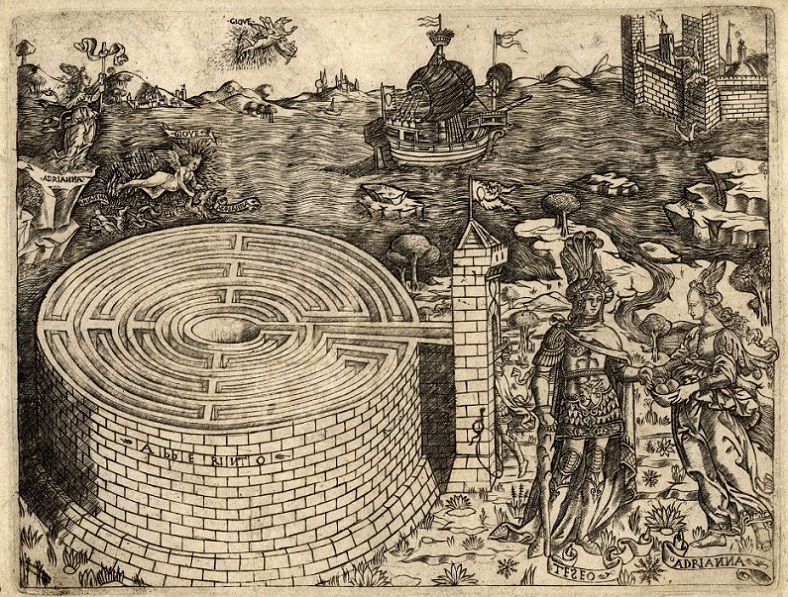
Baccio Baldini: The Cretan labyrinth with the story of Theseus and Ariadne




This small article by the Italian archaeologist Massimo Cultraro is more about labyrinths than about Plato's Atlantis. This review concentrates on the statements about Plato's Atlantis. What is said about labyrinths may be good and valuable, but concerning Plato's Atlantis we have to intervene with criticism.
Cultraro claims that Diodorus Siculus drew a connection between Atlantis and Crete, since he wrote about Zeus, born in Crete, and his brother Atlas, identified by Cultraro with the king of Atlantis (Diodorus III 54, 56). Since then, allegedly, the themes of Atlantis and Crete were connected (p. 62).
Furthermore, Cultraro claims that in the works of the Neoplatonists the symbolic understanding of Plato's Atlantis and the symbolic understanding of the island of Crete became interchangeable (p. 63).
And it is claimed that Hermann Kern allegedly demonstrated that "the assimilation of the Cretan labyrinth with Jericho, via the myth of Atlantis, seems to have originated in the Syrian world of the 4th and 5th centuries." (p. 66; original: "Come ha dimostrato H. Kern, l’assimilazione del labirinto cretese con Gerico, passando attraverso il mito di Atlantide, sembra aver avuto come luogo d’origine il mondo siriano del IV e V secolo.")
A picture from the Collectio Antiquitatum of Giovanni Marcanova from 1465 has been given the description "Il Labirinto di Creta versus l’Atlantide platonica" (p. 76).
All in all, Cultraro tries to demonstrate an early connection between Plato's Atlantis and Crete which came into being only much later in the 19th century, via the exploration of the Minoan civilization and via the discovery of the Thera eruption. One of the travelers to Crete mentioned by Cultraro, Joseph Pitton de Tournefort (1656-1708) said it himself: For him, Atlantis was in the Atlantic sea. But Cultraro did not notice this.
Since Massimo Cultraro relies on the highly erroneous book of Pierre Vidal-Naquet (and on L. Sprague de Camp), we find many mistakes repeated by Cultraro. For example that Atlantis would transcend the real world by its fabulous richness (p. 61). Yet the richness of Atlantis is not "fabulous", and Atlantis does not transcend the real world in any way. Compared to Herodotus (e.g.), the construction works in Atlantis are not bigger than the biggest known construction works, and also the age of Atlantis is not the oldest age, and even the Orichalc is only second to gold, etc. etc.
According to Cultraro, the Christians brought about a change of perspective in Atlantis research. He quotes Tertullian as an example. However, it remains unclear what the change of perspective should have consisted of, because Tertullian considers Atlantis a real place, just like others before him. It were rather those Christians who deduced from the Bible an age of the world of 6,000 years or less who brang about a change in perspective by starting to criticise the 9,000 years of Atlantis as impossible.
The opinion of Cosmas Indicopleustes is also misrepresented. Cosmas refers to Plato's Timaeus, yes. But he does not endorse it. He opposes Plato's depiction and considers it a garbled version of the biblical story.
Also in the line of Pierre Vidal-Naquet, Massimo Cultraro has made the big mistake that practically no one wrote about Plato's Atlantis in the Middle Ages (pp. 63, 72 f.). This is, of course, completely wrong, and Cultraro thus overlooks the basis on which the Renaissance continued to build its ideas about Atlantis.
Massimo Cultraro is a very capable and renowned archaelogist, but with the statements about Plato's Atlantis in this small article he deviated from the usual level of quality. This is highly forgivable since Cultraro relied on the rotten state of contemporary academic Atlantis research. We had to point out the mistakes nevertheless.
Thorwald C. Franke, Kritische Geschichte der Meinungen und Hypothesen zu Platons Atlantis – von der Antike über das Mittelalter bis zur Moderne, 2nd edition in two volumes, published by Books on Demand, Norderstedt 2021. First edition was 2016 in one volume. There is no English translation yet.
Hermann Kern, Labyrinthe – Erscheinungsformen und Deutungen: 5000 Jahre Gegenwart eines Urbilds, Prestel-Verlag, München 1982.
"Codice Marcanova" (digitized): Modena, Biblioteca Estense Universitaria, lat. 992 (alfa.L.5.15)
https://www.mirabileweb.it/manuscript/modena-biblioteca-estense-universitaria-lat-992-(alfa-l-5-15)-codice-marcanova-manuscript/25638
The British Museum: Picture by Baccio Baldini, The Cretan labyrinth with the story of Theseus and Ariadne.
https://www.britishmuseum.org/collection/object/P_1868-0822-23